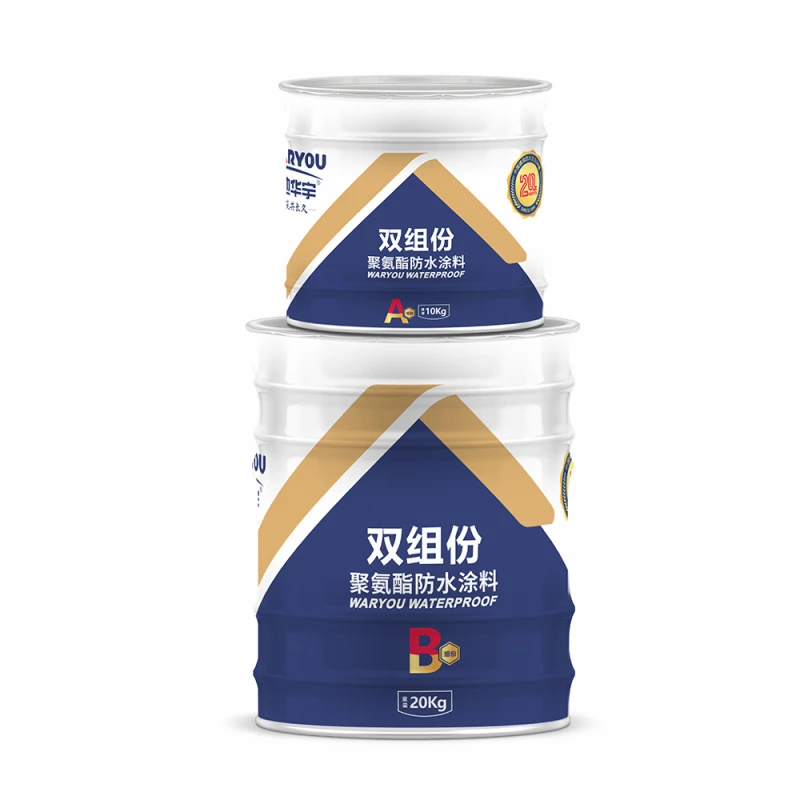Double Component Polyurethane Waterproofing Coating
- Type
- Double Component
- Composition
- Component A; Component B
- Physical State
- Liquid; Liquid
- Density
- 1.05-1.15 kg/L for Component A; 1.5-1.6 kg/L for Component B
- Mixed Viscosity
- 12
- Packaging Form
- 000 mPa·s (25°C)
- Packaging Specification
- Iron drum

Double Component Polyurethane Waterproofing Coating
Type: Double-Component
Composition: Component A; Component B
Physical State: Liquid; Liquid
Density: 1.05-1.15 kg/L for Component A; 1.5-1.6 kg/L for Component B
Mixed Viscosity: 12,000 mPa·s (25°C)
Packaging Form: Iron drum
Packaging Specification: 6 kg/drum for Component A; 19 kg/drum for Component B
Product Description:
The double-component polyurethane waterproofing coating is a reactive high polymer waterproofing material,
composed of Component A (polyurethane prepolymer) and Component B (hardener). When used, mix Components A
and B in a certain ratio, stir evenly, and apply it to the base layer. It reacts and solidifies to form a continuous, flexible,
and seamless rubber waterproof layer.
Product specification:
|
Performance Indicators |
Technical Indicator |
Typical values |
|
Solids Content |
≥ 92% |
95% |
|
Elongation at Break |
≥ 500% |
546% |
|
Real Dry Time |
≤ 24h |
9h |
|
Surface Dry Time |
≤ 12h |
7h |
|
Low-Temperature Flexibility, |
-35℃,Crack-free |
-35℃,Crack-free |
|
Watertightness |
0.3MPa,120min,water tight |
0.3MPa,120min, water tight |
Product Features
1、Excellent physical and mechanical properties: Composed of pure polyurethane, it has good rubber elasticity and resilience, high tensile strength, and strong resistance to substrate deformation (shrinkage and cracking);
2、Good adhesion, strong bonding power, can adhere to different substrates, and can be directly applied on suitable substrates with an adhesive strength of over 1.0MPa;
Good construction performance, the two components can be mixed in a certain ratio for immediate application;
3、Thick application is possible, 2-3 coats can achieve a thickness of 2mm, with a dense and defect-free coating,
no pinholes, and no bubbles;
4、Excellent water resistance and corrosion resistance, chemical reaction film formation, resistant to water erosion, corrosion, and mildew, making it particularly suitable for waterproofing in areas subject to long-term water immersion;
5、Excellent low-temperature flexibility, no cracks at low temperatures (-35°C), suitable for waterproofing projects in
low-temperature environments;
6、Environmentally friendly, using high-boiling-point solvents, without adding toxic solvents such as benzene, toluene, xylene, and no coal tar components.
How to Use
Construction dosage: Approximately 1.5 kg/㎡-1.7kg/㎡of coating is required for each millimeter thickness of the coating.
Construction process: Subgrade treatment → Detailed additional waterproof layer construction → Large-area coating waterproof layer construction → Finishing and edge sealing → Quality inspection and acceptance → Protective isolation layer construction.
Key points of construction:
1. Subgrade treatment: The waterproof subgrade should be flat, solid, and dry, without sharp concave-convex, honeycombing, pockmarks, or peeling, and free of oil contamination. For cracks, substrate deformation joints, and
recesses around pipes, sealants should be embedded and additional waterproof treatment should be applied. A flat and solid subgrade does not require a subgrade treatment agent. For loose and porous substrates, or when constructing in high-temperature and high-humidity or sun-exposed environments, it is recommended to use a special subgrade treatment agent, which can greatly improve the quality of the on-site construction coating.
2. Mixing: Pour component A into the packaging bucket of component B and mechanically stir for 5 minutes until uniform. The mixed product must be used as soon as possible. For small amounts of mixing, first stir component B evenly, use a dry and clean container to strictly measure according to the specified ratio (refer to the product label), and then mechanically stir before use.
3. Detailed additional waterproof layer construction: For basic details such as inside and outside corners, pipe roots, and deformation joints, additional waterproof layer construction should be carried out first, and 2-4 coats can be applied (with a total thickness of not less than 1mm). If a reinforcing material is needed, it must be soaked thoroughly. For deformation joint areas, first lay a layer of polyester non-woven fabric, then apply the coating to form an additional waterproof layer with an empty laid structure.
4. Large-area coating waterproof layer construction: Apply evenly with a rubber or metal scraper, preferably in 2-3 coats.
The first coat should be thin to seal the substrate pores. After the previous coating is fully dry, the next construction can be carried out, usually with an interval of 24 hours (extend the drying time appropriately in low-temperature environments).
The brushing direction for the next coat should be perpendicular to the previous one. If a reinforcing material is to be laid, it should be done while applying the coating.
5. Finishing and edge sealing: Apply additional coatings for sealing.
6. Protective isolation layer construction: After the coating waterproof layer is accepted as qualified, the protective isolation layer can be constructed according to relevant specifications or design requirements.
Precautions
1、The construction temperature should be between 5°C and 35°C, and construction should not be carried out in rain or snow.
2、Construction should be carried out in well-ventilated conditions, and construction personnel should take appropriate safety precautions.
3、Use directly without adding any thinners. If thinning is necessary, consult the corresponding technical personnel and conduct a small-scale test on-site to ensure it does not affect the product's drying speed before using it on a large scale.
Product Application:
It suitable for waterproofing projects in underground engineering, bathrooms, kitchens, balconies, pools, parking lots, etc., and can also be used for non-exposed roof waterproofing projects.
We have more categories for you. lf you can't find the products you want above,just fill in the form and tell us whatproducts you want to import from China.













